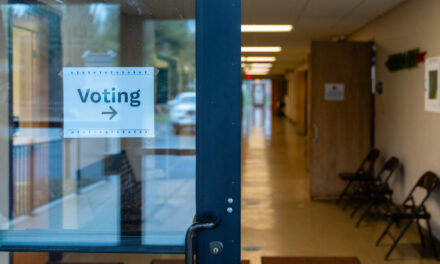We support our Publishers and Content Creators. You can view this story on their website by CLICKING HERE.
This year, a quarter of the public high schools in Fairfax County, Virginia, located just outside of our nation’s capital, are likely to lose state accreditation. The declining performance of students, particularly concentrated in six failing high schools, coincides with the rising number of non-English speakers in the district after the board of supervisors passed a sanctuary policy titled “The Public Trust and Confidentiality Policy (Trust Policy)” in January 2021. By 2023, students classified as English-language learners accounted for 26.5 percent of the district’s students.
Fairfax County is among the last places one would expect to see failing schools. It is an affluent area with a median household income of about $145,000. Within commuting distance to Washington, D.C, the county is home to a high percentage of residents with advanced degrees, has one of the largest public school districts in the nation, and is one of the top per-pupil public school district spenders (totaling about $20,000 per student in fiscal 2024). For decades, Fairfax County has drawn families in search of quality K-12 public education for their children.
Virginia’s Performance Indicators for Accreditation
A look at Virginia’s accreditation metrics and the recent arrival of students who are not proficient in speaking and reading English sheds light on the significant decline of Fairfax County’s public schools. In Virginia, public school districts are assessed on the following school quality indicators: academic achievement, academic achievement gaps, chronic absenteeism, dropout rates, the Graduation and Completion Index, and the College, Career, and Readiness Index.
Each school is graded in every category on a level one to level three rating. A performance rating of level one indicates “at or above standard” and level three means a school is performing “below standard.” Any school that earns a level three for any of the quality indicators is put on probation, or “accredited with conditions.” The conditions are that the school needs to follow the state’s guidance to improve performance for that indicator or the school will subsequently lose its accreditation.
The institutionalized secrecy associated with the sanctuary policy in Fairfax County makes assessing which English-language learners are in the country legally or illegally difficult. It is clear, however, that the number of English-language learners has increased substantially since the implementation of the sanctuary policy. With this rise in migrant students, the school district is facing an intensifying problem with two particular state accountability metrics — chronic absenteeism and drop-out rates.
Non-English Speakers Have Flooded the Failing High Schools
Fairfax County’s Justice High School, for example, is currently accredited with conditions and is at imminent risk of losing accreditation. According to data provided by the Virginia Department of Education, its dropout rate was 13.99 percent in 2023. Meanwhile, its rate of chronic absenteeism, defined as the percent of students who missed 18 or more school days in the school year, was 24.63 percent. Justice High School’s dropout rate is rated at a level three, and it’s at level two in chronic absenteeism, the College, Career, and Civic Readiness Index, and the Graduation and Completion Index.
Like many of the failing schools in Fairfax County, Justice High School experienced a substantial increase in English-language learners following the sanctuary policy. Information obtained from a Freedom of Information Act request shows that in 2020, the high school had 705 English-language learners. By academic year 2023-2024, 1,907 students (79 percent) of the school’s 2,406 students were English-language learners, and 312 students (13 percent) were newly arrived from other countries and enrolled for their very first year in an American school.
The five other failing high schools in Fairfax County share the same trend as Justice High School with the rise of English-language learners, or multilingual learners as they are labeled in Fairfax County.
Number of Multilingual Learners Enrolled in Fairfax County’s Failing High Schools
Compounding Fairfax County school district’s problems, the Virginia Department of Education granted its public schools a three-year waiver for chronic absenteeism in the wake of the Covid-19 pandemic, but that waiver expired this academic year. Chronic absenteeism and drop-out rates are more significant problems for children who have recently crossed our southern border.
In addition to the expiration of the chronic absenteeism waiver, this year, the Virginia Department of Education revised the state’s accreditation standards to hold public schools accountable for teaching their English-language learners. Instead of an 11-semester waiver (more than five years) for newly arrived students to take the standardized English reading test, they now are granted a waiver for three semesters. This means that more of Fairfax County’s English-language learners will be taking the state’s standardized reading test this year, likely decreasing already low-performing schools’ overall test scores and increasing their academic achievement gaps.
The data clearly indicate that Fairfax County’s once thriving school district is struggling as it is being flooded with newly arrived English-language learners. Rather than taking up the issue with the board of supervisors for its problematic sanctuary policy, the school district’s leaders are complaining that tests are not sufficient to measure knowledge, that the state’s standards are unfair, and that Republican Gov. Glenn Youngkin released the standardized test data prematurely (despite it being in line with the U.S. Department of Education’s requirements).
Hiding Low-Performing Students to Bolster the School District’s Image
Fairfax County’s 12 Democrat-endorsed school board members and the superintendent, Michelle Reid, further support measures to hide low performance among students, such as equity grading and performance-based assessment projects to replace standardized testing. Some students further are offered make-up days to show up to school on non-school days in order to reduce the appearance of chronic absenteeism. During these “make-up” days, attendance is called, but there is little to no accountability for student learning.
These strategies are meant to make schools appear that they are performing better, rather than to facilitate the genuine education and learning of the district’s most vulnerable students. The goal of Fairfax County’s public schools is clearly to reduce the standards for the sake of appearances. The notion of “equal outcomes” is at the center of the district’s strategic plan. What that seems to mean is that the district’s leadership is fine with students learning little and faring poorly together, as long as the district looks good.
This strategy is failing because many of the newly arrived students who are not proficient in English are concentrated in certain areas of the county. So, the district has introduced Policy 8130 to completely redistrict Fairfax County. Some high-performing students with great attendance will be shuffled to low-performing schools, and many of the chronically absent, low-performing students likely will be moved to higher performing schools.
Fairfax County’s public education system is a cautionary tale for school districts across the country. Even the most affluent counties’ school districts cannot perform well when they are inundated with newly arrived English-language learners from other countries. Trying to hide poor performance and refusing to address the root cause of school failure is only doing a disservice to our taxpayers, and more importantly, to our children.
Stephanie Lundquist-Arora is a contributor to The Federalist and the Washington Examiner, a mother in Fairfax County, Virginia, an author, and the Fairfax chapter leader of the Independent Women’s Network.

 Conservative
Conservative  Search
Search Trending
Trending Current News
Current News 





